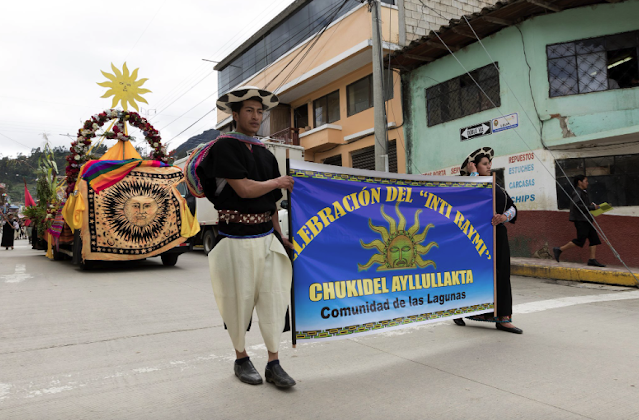Inti Raymi the Sun God Festival in Saraguro, Loja, Ecuador
The Inti Raymi festival every June in Saraguro, Ecuador, is Loja's closest living link to the great Incan Empire that once dominated all of western South America. 'Inti,' the name of the Incan sun god, and 'raymi,' the Quechua word for festival, is considered the most important of the four sacred festivals celebrated by indigenous Andean cultures every year. Inti receives the people’s offerings on the longest day of the year corresponding to the summer solstice.
During Incan times before the arrival of the Spanish conquistadors, Inti Raymi was the largest of the four original ceremonies celebrated in Cusco, Peru, at the heart of their powerful empire. Multicultured writer "Inca" Garcilaso de la Vega, who was of both Incan and Spanish heritage, witnessed the pageantry during colonial times before it was banned in 1535 by Spanish viceroy Francisco de Toledo. Toledo considered it a pagan ceremony and contrary to the Catholic faith. Nonetheless, son god rituals continued clandestinely throughout the centuries.
According to Vega, the observance took place in the Haukaypata or the main plaza in the city. Inti is believed to be the highest god of the Incan pantheon. Religious celebrations in his honor were held with songs, dances, and offerings giving thanks for the abundance of the crops provided by his light and the fertile mother earth. A very small part of this offering was consumed on the altar itself and the remainder was destined for the public feast that the sun god gave to his beloved people.
Current day Inti Raymi festivals in Quechua territories are based on an historical reconstruction created by Faustino Espinoza Navarro in Cusco from Vega's chronicle of the time. From the first reenactment in Peru in 1944 until the present day the ceremony is again a public event. Now celebrated throughout the Andes by descendants of the Incas, Saraguro's observance lasts 15 days.
The culmination of the festivities on the final day commences with an early morning ritual bath. Communal purification bathing rituals are in the hamlet of Las Lagunas (Chukidel Ayllullakta) close to the center of Saraguro. There is believed to be some evidence of Incan modification and decoration there. In this "Baño del Inca," there is supposedly a seat carved into the bedrock from which the main water basin is formed. The purifying and healing baths feature hot and cold water at five o'clock in the morning.
Saraguro's people then parade in full traditional costume from the baths to their central square. A communal meal, singing and dancing are the centerpieces of the ritual to mark the middle of the calendar, the end of the corn harvest, and the solidarity of the people. The overseers of the festival also stage a formal handover of organizing to the next committee. Although it is known by its Quechua name of Inti Raymi, the holiday resembles celebrations common to many pre-Hispanic peoples of the Andes, and one that likely predates the formation of the Inca Empire.
For more information about visiting Saraguro and/or experiencing this celebration, contact Life in Loja by email, or phone/WhatsApp at 593-098-674-5994.
Life In Loja is registered under Ecuador’s department of intellectual rights as of 2022.
Story: UNESCO, Loja Dirección de Turismo, Gorrayme, Ecudordotgob,Wiki, Macas UNL. Photos: saraguro.gob.ec





Comments
Post a Comment